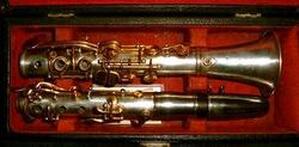 This idea for a post came from a customer question: 'How can I tell the difference between LP and HP clarinets?" Its a damn good question! For those of you who aren't familiar with the terms, LP stands for Low Pitch (A=440) and HP for High Pitch (approx. A=456). The latter was a pitch system in use in Europe in the late 19th/early 20th cen, and crossed the ocean with emigres bearing clarinets. Thankfully, it died out in the 30's, as the two systems are about a quarter tone apart and little or nothing can be done, (with longer barrels, etc.), to reconcile the two! You'll see these poor beasties on eBay with some frequency and they always have a lonely, under-appreciated look to them, generally selling for $30 or $40 to someone who didn't ask for markings or measurements and thinks they're getting a hell of a deal! Well, they are, after a fashion: I've had a couple show up here and had to sit the owners down, with a box of Kleenex, and explain the harsh realities of multiple pitch systems to them. The sad thing is that identification is not difficult! In the 1920's, with LP ascendant and HP on the way out, most instruments were marked one or the other on the main body sections. Before that, especially with European made instruments, you have to depend on measurements. A modern Bb clarinet is 23 3/8" assembled, without the mouthpiece. I've seen older examples that varied from 23 to 23 1/2", but nothing longer or shorter than that. By the time you're down to 22 7/8 or a bit less, you're looking at a Bb HP. Shun it! Run away! It will make a wonderful lamp or doorstop, but its days as a musical instrument are sadly past, unless you like playing clarinet by yourself... which is a shame, as some of them are wonderful players! Here on my website, I have provided a chart of lengths for HP and LP clarinets in all the common keys (and a couple rare ones). The URL is https://www.thevintageclarinetdoctor.com/clarinet-lengths.html , if you'd like to check it out..
0 Comments
 OK, everything is buffed, clean and corked: now, pads. I like tan kidskin or white Roo leather instead of the traditional fish bladder: they last longer, seal better on older (uneven) tone holes, give a feel that is more similar to a fingertip and don't show dirt/wear as quickly. I separate out the pile of keys and start sizing new pads. Then, a dab of hot glue in the key-cup and the pad is pressed evenly into place. It takes practice to use just enough glue to get it far enough into the cup to close, but not so far that the back is open when you go to adjust! A final check of bodies, posts, springs, etc. and then I start reassembling, generally doing both stacks at the same time, working on one while the other has a pad clamped and cooling. I put the key on the instrument, making sure that it is a snug fit but not binding and that the rod/screws are clean and oiled. Also, make sure that the key-cup is centered over the tone-hole and isn't higher on one side than the other; you'd be amazed what these go through in half a century or more! Heat the pad cup for a couple seconds with the torch, use a pad slick to give the pad a twist and level it, check for even coverage with a feeler, then clamp lightly (I like flute pad clamps) for a minute and on to the next key. Once all the keys are on and the pads are seated, I do simultaneous adjustments: upper A/Ab, (screw adjustment if you're lucky!), crows foot on the lower body. Removing lost motion while allowing pads to close at the same time with exactly the same amount of pressure is the trick. OK, everything closes, seals and is properly adjusted - you're done! Oh, wait a minute; there's the play test and final adjust....  Continued... OK, the previous post covered tear-down and preparation, now let's cover cleanup and rebuild: I have a box full of body parts and keys in front of me; time to clean them! I rag the keys to remove the buffing compound residue, and give a final polish with a silver polish cloth. Strips of the same cloth are used to get in and around the posts and remove schmutz from the wooden pieces, as well. Don't forget to clean (and, if need be, polish) the bore and give it a light oiling! Once all is clean, I go over the body to see if any tone-holes need attention: if they all look crisp, I'm good to go. If any show dings, nicks, or roughness from the original cutter being a little dull, I take out a special set of re-facing tools and take just a couple thousandths off the tone-hole, removing any damage and restoring the sharp, clean edge. This really helps with pad seat and seal, especially on older horns that've received a few (less than ideal) overhauls! This is also a good time to check posts again for tightness, make sure all the springs are good, and re-gild the logos if they look worn - it really sharpens up the look of the finished job! The next step is re-corking the keys and body: if you've buffed, those corks are toast! Sort those keys into piles for the right thickness of cork, clean off traces of old cork and adhesive and hit the appropriate spot with a coat of rubber cement. I use 4 or 5 different thicknesses of cork to get the keys to open and close to the proper degree - this is important! Not open enough and the note sounds stuffy and plays flat; too open, and the note sounds harsh/plays sharp and gives the player a feeling of wasted motion. This is a critical part of assuring that the finished horn has good intonation and even tone and mechanical response! For corking the body tenons, I measure the inside diameter of the opposing socket and the outside diameter of the tenon slot with vernier calipers and figure what thickness of cork will provide a snug fit without being thick enough to risk cracking the body when I put it back together! Oh, did you remember to tighten those body rings if they were loose? They often are from wood shrinkage, and that's where body cracks come from.... To Be Continued..... 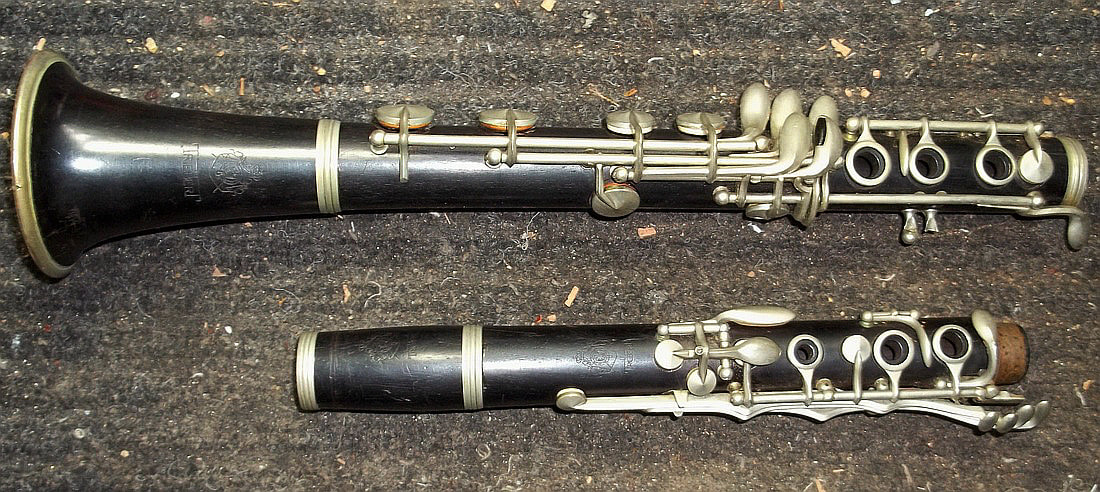 Continued... Well, here's where it gets interesting (if not long before). When I get it on the bench and start looking it over, here are some things that I'm looking for/thinking about: "Man, does this case reek - did something die in here? Can't put a finished horn back in this cesspool - out goes the case..." "Can I even get it this horn apart?" Are any rods or screws rusted in? Heat, oil, perfect screwdriver...heat oil, perfect screwdriver, pray, curse....cut into post, remove damned rod surgically, replace post from junk box, maybe make new rod from scratch, if I don't have one that fits (with threads that match) in the junk box.... "Is the key work tight or loose and rattily?" If the latter, it needs to be swedged and/or countersunk to tighten it up: more specialized tools, and some practice and instruction to avoid seriously botching the job. This needs to be done before you pad, as it will affect the final seat of the pad! This is almost always necessary on any horn more than about 30 years old, and yet I'm surprised how often I see full overhauls done with loose, rattily key work! "Are the keys dull, oxidized or worn?" Nickel silver (or nickel plating) is a wonderful but obdurate alloy - you can't really polish it, you have to buff! Downstairs to that fast, powerful 2 wheel buffer - hope you have one (and the right wheels and compounds) and know how to use it without hurting yourself or wrapping that key around the shaft...ouch.. "Now, how does the wood look?" Any cracks or chips? Better fill or pin those, file, sand... Most instruments don't get enough bore oil and, if they've been in storage for 20+ years, they REALLY don't get enough oil. Better coat all 4 pieces inside and out with a good grade of bore oil; and coat, and re-coat....sometimes for days or weeks.. Any loose posts from dry wood shrinkage? Better tighten those so the keys don't bind when I reassemble... Any broken or worn out springs? Better replace those... Hope I have the right size or one of my suppliers still carries them... Time to buff the body (avoiding those delicate logos, of course): back downstairs and try to get the posts and body nice and shiny without breaking any springs...whoops... To Be Continued.... 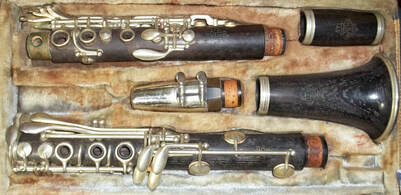 A few people a year write and ask how they can repad their own horn, and, after a decade in this business, I am still struggling to come up with a reply that is wise, kindly, succinct, helpful... After all, you just take it apart, get some pads from somewhere, glue them in with something, and reverse the procedure, right? Job over. The frightening truth is that, with companies like Ferree and Music Medic, its easier than ever to order pad sets, cork and all the specialized tools you'd need to do the job...well, I wouldn't say right, but perhaps passably: If you're a handy, organized person and have a recent plastic Yamaha clarinet in front of you, you might do OK. Take all the keys off (don't get all those little rods mixed up!), replace a few pieces of cork (make sure to get the thickness right!), wash the body, take out the old pads, pop in the new ones with a hot glue gun (don't forget to level them so they seal!), put it all back together (don't forget to synchronize the keys that open or close together!). Are you done? On that horn, you might be. But what if you decide to tackle an older, pro instrument - something that you really will want to play, like the 1950's 7 ring wooden Leblanc pictured above? Its gorgeous and it was so cheap on eBay... Congratulations, you've just entered Hell! 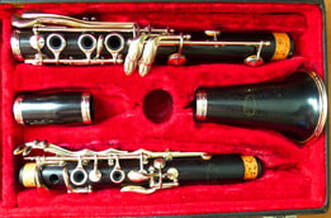 Just finished this M. Lacroix Bb Boehm clarinet and it plays so well that I'm wondering if anyone knows who made it? Was Lacroix a maker or is this a stencil? It reminds me a lot of a Thibouville Freres, both in construction quality and response. It has thick ring keys, post lock-downs on the lower stack and the lowest (double) post on the upper stack is silver soldered to a bar with 2 screws in the body - much like Selmer or Buffet - rather than just screwed into the body like many contemporaries. It also has a leaf spring under the C#, screw adjustment for Ab/A, and 2 posts for the LH pinky keys rather than one. I've done some looking around online and found no info. This is too good a horn to remain anonymous! Tone is warm and focused, intonation is good, response is very even through the registers and the throat tones speak well. You could spend a lot of money today to get as good an instrument! Would love to hear from anyone with inside information :) A local man called this week and said he had a Conn clarinet that his aunt gave him in the 1940's and wondered if I could restore it for his daughter to use in community band? I said, 'Sure, bring it on in', expecting maybe a 424N or, if he was lucky, a 444N.
When they arrived it turned out to be this 1925 4N Albert system in hard rubber: We were all surprised! I'm still amazed at the number of old Alberts that continue to turn up in closets and attics after all these years. I explained to them that a few of the fingerings would be a bit different but, as the instrument plays at Bb LP, there was no reason she couldn't give it a whirl if so inclined. They said 'Yes, go ahead' so here, a few days later, is the finished article. Its a nice player, with comfortable keywork and a full Albert tone, and I look forward to giving it back to them today - she's so excited!  OILING Most of the instruments that I receive are pretty dry, and the first thing I do, after disassembly, is coat them inside and out (not forgetting the tone holes) with a good grade of bore oil. Then they get a few days to rest, with re-applications of oil until they stop absorbing. Rehydrating the wood helps cushion it against cracking due to moisture absorption, thermal shock, etc. and gives it a better chance at a new life... BUFFING With solid nickel alloy or nickel plated keys, there is no way to remove 40 years worth of greenish-grey, crusty oxidation other than buffing - period: I don't want to see one more horn with silver polish residue under the keys! A high speed buffer with white lime compound will return a key to brand new in seconds, and take years off the wood body as well - just watch those toneholes and logos, and try not to break any springs... TONE HOLE REFACING On older wood clarinets, toneholes suffer from a variety of problems. Years of adjustment and overhauls (especially careless ones) can leave small nicks and gouges around the rim of the toneholes, causing tiny leaks. It might not seem like a big deal, but multiply that by every tonehole on the clarinet… As the instrument ages, it dries and shrinks: as it heats and cools, it flexes. A tonehole that was cut flat into a curved surface 50 or 80 years ago has often developed all kinds of minor warps which, when they meet a perfectly flat pad surface (if there is such a thing!) fail to contact evenly all the way around, causing yet more sealing issues. The only way to effectively solve these problems is to re-cut the rim to its original contour.A special set of cutters is used to remove just a few thousandths of an inch of material, eliminating nicks and rendering the tonehole flat again, allowing for the best possible seal. To be continued....  Many techs who routinely repair only band grade instruments have neither the time, the knowledge, nor the specialized tools to complete all these tasks, and little incentive to acquire them: At the $60 an hour that the average shop currently charges (plus supplies), a $600 bill wouldn't be out of the question and few customers are discerning or serious enough to make this kind of commitment to their instrument. Trying to explain why all this is necessary frequently got me looks suggesting that I was peddling Snake Oil: We are, after all, a nation of bargain hunters, and quality work is no bargain! However, once your older instrument has been thoroughly overhauled in this manner, you can be assured that, not only is it playing its best, but that it will require little maintenance other than oiling, adjustment and occasional pad replacement for years to come! Below I include some technical definitions for the curious and foolhardy... Swedging/Countersinking As clarinets age, the keys get loose from wear and dirt: metal is actually ground away at each end where it rubs against its post! Once the problem becomes severe enough, pads will no longer align properly with toneholes (causing leaks) and the whole instrument will have a loose ‘clackety’ feel. Swedging, which is the technique used on keys with a through rod, is the process of compressing the metal at the end of the key to extend it and bring it back tight against the post. For solid keys that pivot on a screw, we countersink: slightly deepening the hole in the post until the point of the screw once again makes firm contact with the key and keeps it from shifting. Properly done, it can restore an “almost new” feel to the mechanism, help eliminate leaks, and quiet the instrument... To be continued  For the many years before the Vintage Clarinet Doctor did repair, I'd turn one of my instruments over to a repairman with mingled optimism and dread. Does he know what he's doing? What does 'overhaul' really mean? Why does one person charge significantly more than another? Are there any approved procedures or industry standards, or does anything go? I'd like to address a few of those concerns, and try to shed light on some of the mysterious things that a good tech does (or should do) to a horn: On a newer plastic student horn, a re pad might only include dis-assembly, washing the body, quickly hand-ragging the keys, replacing missing corks, replacement of all pads, reassembly and adjustment: about a 2 1/2 hour job for about $150. For an instrument with fresh tone-holes, snug posts, tight mechanism, shiny nickel plated keys and recent springing this might be sufficient, especially if its going into the hands of an 11 year old of indifferent ability. An overhaul, on the other hand, would include everything necessary to return the instrument to as close to 'like new' playability as is feasible (sometimes extraordinary measures are not justified by the value of the instrument), and address the preferences of the more advanced player in question. This might include: Swedging/countersinking the key-work to remove lost motion, re-facing of tone-holes to assure optimal pad seat, tightening of loose posts, replacement of all cork (including adjustment of opening height to regulate tone and intonation), thorough oiling of body, buffing of body, posts and keywork, polishing of the bore, straightening or leveling of bent keys, key cups and rods, realignment of keys with tone holes, replacement of weak springs, repair of small cracks or chips, installation of a mix of high quality leather and cork pads, reassembly and adjustment, and re-gilding the logos! Total of 6-10+ hours depending on age, complexity of mechanism, and condition. To Be Continued.... |
Archives
February 2024
AuthorThe Licorice Shtick Blog is the creation of the Vintage Clarinet Doctor, a Winston Salem, NC based woodwind instrument repair shop specializing in vintage and antique clarinets, saxophones, and the occasional flute. Categories |
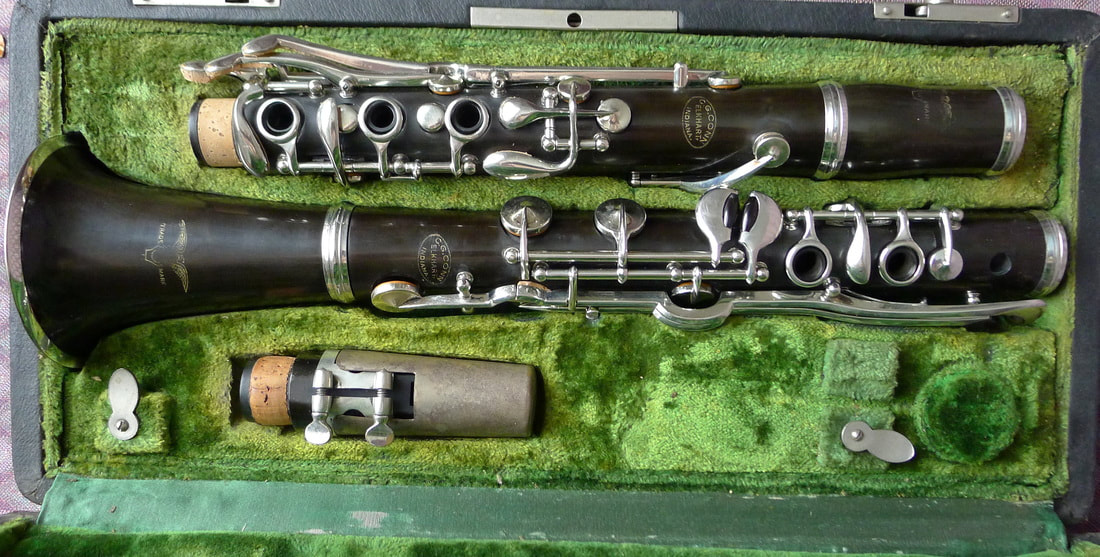
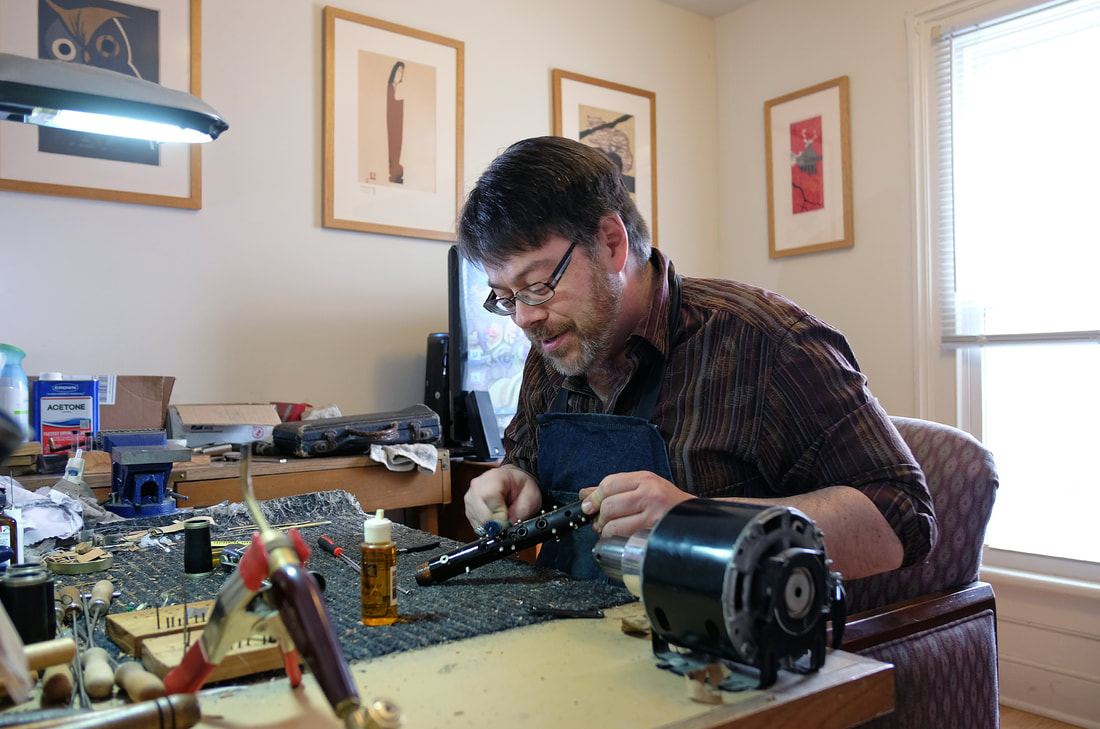
 RSS Feed
RSS Feed